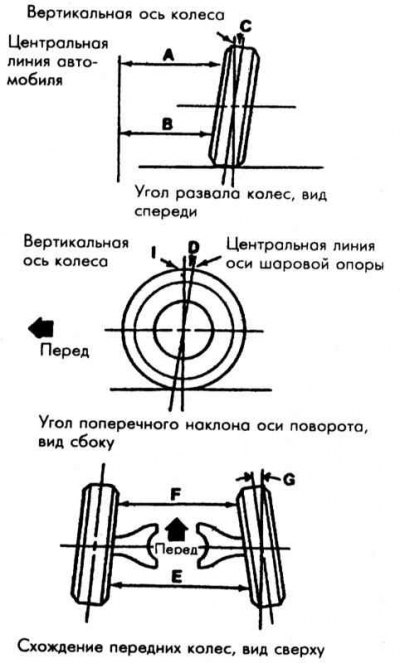
1 - A minus B = C (collapse in degrees)
2 - E minus F = wheel alignment (expressed in mm)
3 - G = wheel alignment (expressed in degrees)
Front wheel alignment is an adjustment that is made to the front wheels so that they are at the correct angle to the suspension and to the ground. If the front wheel angles are incorrectly set, not only will steering be affected, but tire wear will also increase. Typically, camber, lateral tilt and toe are measured on the front wheels (discrepancy) front wheels. Convergence (discrepancy) front wheel adjustable on all models; the angle of the transverse tilt of the axis of rotation is not adjustable. The camber is adjusted only by replacing the top support of the suspension strut with a special eccentric model. Convergence (discrepancy) it is also adjustable on the rear wheels, but only by replacing the outer bushings of the trailing arm with special eccentric bushings.
Setting the angle of the front wheels is a very precise job that requires complex and expensive equipment to do correctly. Therefore, it is best to call a mechanic with the necessary tools to carry out this procedure. However, in order for you to better understand this process and better interact with the workshop that performs it, we will give here the basic idea of what it is.
Convergence angle (discrepancies) is the inward deflection of the wheels. The purpose of setting a certain angle is to ensure that they rotate in parallel. If the car has a zero toe angle, then the distance between the front edges of the wheels will be equal to the distance between the rear edges of the wheels. The actual value of the angle of convergence is usually very small. The toe angle of the front wheels is controlled by the position of the tie rod end relative to the tie rod. The toe angle of the rear wheels can only be adjusted by installing special eccentric bushings on the outer support of the trailing arm. An incorrectly set toe angle will cause uneven tire wear due to the fact that they will scrape the road surface.
Camber is the deviation of the wheels from the vertical axis, when viewed from the front or rear of the car. If the wheels are deflected outward at the top, then such a camber is called positive (). If the wheels at the top are deflected inward, then the camber is called negative (-). The amount of deflection is measured in degrees from the vertical line, and this amount is called the camber angle. This angle affects the number of tread treads that make contact with the road and is offset by changes in suspension geometry as the vehicle turns or travels over rough roads.
The angle of the transverse inclination of the axis of rotation is the deviation of the axis of the front kingpin from the vertical. The deflection at the top back is a positive angle, and the deflection forward is a negative lateral tilt angle of the axis of rotation. This angle is not adjustable on the vehicles covered in this manual.
